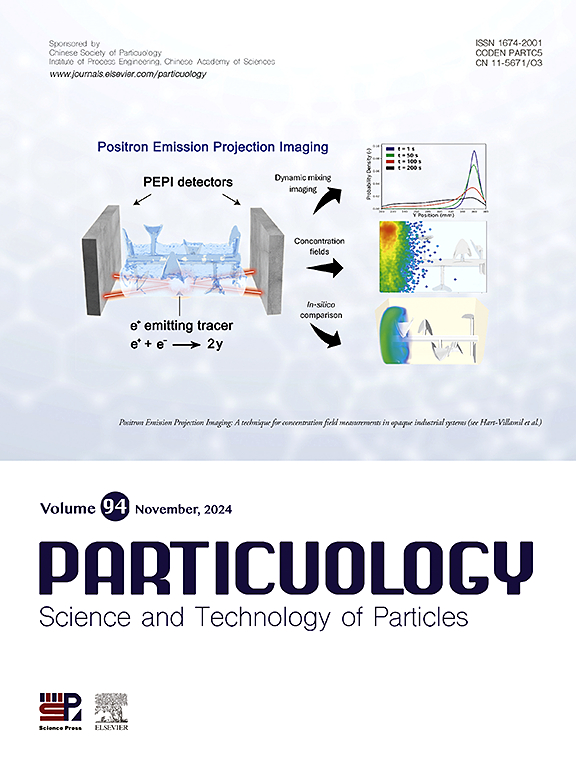载锂蒙脱土的构效关系:八面体锂锁定机制
IF 4.3
2区 材料科学
Q2 ENGINEERING, CHEMICAL
引用次数: 0
摘要
含锂黏土矿物的结构复杂性和传统表征方法的局限性阻碍了从蒙脱石型矿石中高效提取锂。本研究采用密度泛函理论阐明了锂在蒙脱土中的结构-活性关系,特别强调了八面体锁定机制和界面反应障碍。系统计算揭示了四个潜在的锂赋存位点:Al-O八面体、Si-O四面体晶格、层间位点和Li取代H位点。锂在Mg-Al-O八面体晶格中表现出最佳的稳定性,表现出最低的相互作用能(- 672.982 kJ/mol)和大量的Mulliken电荷转移(2.35 e),证实了这种结构是主要的承载环境。态密度分析揭示了关键的电子结构特征:锂的1s轨道与费米能级保持能量隔离,解释了它的化学惰性和对直接浸出的抵抗力。相反,氧在费米能级附近的活性2p轨道有利于与浮选试剂的表面相互作用。这些电子签名意味着浮选回收与湿法冶金方法的可行性。八面体锁定机制源于锂离子诱导的动态对称重构。该过程通过键角正则化实现了能量最小化,而Al-O/Mg-O键的显著收缩增强了静电耦合。这些协同效应最终建立了结构-电荷双锁机制。这项研究提供了对锂赋存机制的原子水平的见解,解决了粘土型锂矿物学的关键空白,揭示了结构-活性关系,通过界面调节指导可持续的锂回收。本文章由计算机程序翻译,如有差异,请以英文原文为准。

Structure-activity relationships in lithium-hosting montmorillonite: Octahedral lithium locking mechanisms
The structural complexity of lithium-bearing clay minerals and limitations of conventional characterization methods impede efficient lithium extraction from montmorillonite-type ores. This study employs density functional theory to elucidate structure-activity relationships governing lithium occurrence in montmorillonite, with particular emphasis on octahedral locking mechanisms and interfacial reaction barriers. Systematic calculations reveal four potential lithium occurrence sites: Al-O octahedra, Si-O tetrahedral lattices, interlayer sites and Li substituted H site. Lithium demonstrates optimal stability within Mg-Al-O octahedral lattices, exhibiting the lowest interaction energy (−672.982 kJ/mol) and substantial Mulliken charge transfer (2.35 e), confirming this configuration as the primary hosting environment. Density of states analysis uncovers critical electronic structure features: the 1s orbital of lithium remains energetically isolated from the Fermi level, explaining its chemical inertness and resistance to direct leaching. Conversely, the reactive 2p orbital of oxygen near the Fermi level facilitate surface interactions with flotation reagents. These electronic signatures imply the feasibility of flotation recovery alongside hydrometallurgical approaches. The octahedral locking mechanism originates from Li-induced dynamic symmetry reconstruction. This process achieves energy minimization through bond-angle regularization, while the notable contraction of Al-O/Mg-O bonds enhances electrostatic coupling. These synergistic effects ultimately establish a structural-charge dual-locking mechanism. This study delivers atomic-level insights into lithium occurrence mechanisms, addressing critical gaps in clay-type lithium mineralogy and revealing structure-activity relationships that guide sustainable lithium recovery via interface regulation.
求助全文
通过发布文献求助,成功后即可免费获取论文全文。
去求助
来源期刊

Particuology
工程技术-材料科学:综合
CiteScore
6.70
自引率
2.90%
发文量
1730
审稿时长
32 days
期刊介绍:
The word ‘particuology’ was coined to parallel the discipline for the science and technology of particles.
Particuology is an interdisciplinary journal that publishes frontier research articles and critical reviews on the discovery, formulation and engineering of particulate materials, processes and systems. It especially welcomes contributions utilising advanced theoretical, modelling and measurement methods to enable the discovery and creation of new particulate materials, and the manufacturing of functional particulate-based products, such as sensors.
Papers are handled by Thematic Editors who oversee contributions from specific subject fields. These fields are classified into: Particle Synthesis and Modification; Particle Characterization and Measurement; Granular Systems and Bulk Solids Technology; Fluidization and Particle-Fluid Systems; Aerosols; and Applications of Particle Technology.
Key topics concerning the creation and processing of particulates include:
-Modelling and simulation of particle formation, collective behaviour of particles and systems for particle production over a broad spectrum of length scales
-Mining of experimental data for particle synthesis and surface properties to facilitate the creation of new materials and processes
-Particle design and preparation including controlled response and sensing functionalities in formation, delivery systems and biological systems, etc.
-Experimental and computational methods for visualization and analysis of particulate system.
These topics are broadly relevant to the production of materials, pharmaceuticals and food, and to the conversion of energy resources to fuels and protection of the environment.
 求助内容:
求助内容: 应助结果提醒方式:
应助结果提醒方式:


